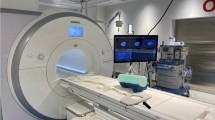Abstract
Background
Lumbosacral plexopathies with unclear etiology are a rare entity. In certain cases, if workup unrevealing and medical management is suboptimal, an open lumbar nerve root biopsy may be considered.
Method
A standard lumbar laminectomy is performed for access to the intradural contents. The dura is opened at midline in a standard fashion. Single nerve roots are selected and stimulated for an EMG response. A nerve fascicle is then dissected and stimulated before excision.
Conclusion
Lumbar nerve root biopsy is feasible and safe. All non-invasive workup needs to be completed and negative before performing this procedure.



Similar content being viewed by others
References
Devereaux MW (2007) Anatomy and examination of the spine. Neurologic Clinics 25(2):331–351. https://doi.org/10.1016/j.ncl.2007.02.003
Ishiyama G, Hinata N, Kinugasa Y, Murakami G, Fujimiya M (2014) Nerves supplying the internal anal sphincter: an immunohistochemical study using donated elderly cadavers. Surg Radiol Anat 36(10):1033–1042. https://doi.org/10.1007/s00276-014-1289-3
MS C, EJ W, CW K, JJ A, GarfinSR (1991) The anatomy of the cauda equina on CT scans and MRI. J Bone Jt Surg Br Vol 73-B(3):381–384. https://doi.org/10.1302/0301-620x.73b3.1670432
Singh O, Al KY (2021) Anatomy, back, lumbar plexus. StatPearls Publishing, Treasure Island (FL)
Van Schoor AN, Bosman MC, Bosenberg AT (2015) Descriptive study of the differences in the level of the conus medullaris in four different age groups. Clin Anat 28(5):638–644. https://doi.org/10.1002/ca.22505
Wall EJ, Cohen M, Massie JB, Rydevik B, Garfin SR (1990) Cauda equina anatomy I: intrathecal nerve root organization. Spine 15(12):1244–1247
Xiang B, Jiao S, Zhang Y, et al. (2021) Effects of desflurane and sevoflurane on somatosensory-evoked and motor-evoked potential monitoring during neurosurgery: a randomized controlled trial. BMC Anesthesiology 21(1):240. https://doi.org/10.1186/s12871-021-01463-x
Yoshimura N, Chancellor MB (2003) Neurophysiology of lower urinary tract function and dysfunction. Rev Urol 5 Suppl 8(Suppl 8):S3-S10
Author information
Authors and Affiliations
Corresponding author
Ethics declarations
Ethical approval
All research and education activities for this manuscript were approved by the appropriate ethics committee and have therefore been performed in accordance with the ethical standards laid down in the 1964 Declaration of Helsinki and its later amendments.
Informed consent
All patient information included has been deidentified and appropriate verbal and written consent for research and education was obtained prior to manuscript preparation.
Conflict of interest
The authors declare no competing interests.
Additional information
Key points
1. The cauda equina is the terminal end of the spinal cord and is located distal to the conus medullaris.
2. The cauda equina nerve roots are arranged in a lateral to medial and anterior to posterior manner.
3. The only indication for lumbar nerve root biopsy is if all other invasive and non-invasive workup has been exhausted.
4. Neuromonitoring with MEPs, SSEPs, and direct stimulation EMG is essential to reduce the risk of postoperative neurological deficits.
5. A positive control needs to be established before proceeding with the dissection.
6. Nerve roots need to be singled out and stimulated before dissection. If negative, a nerve fascicle is dissected and stimulated again. If negative, that fascicle can be excised.
Publisher's note
Springer Nature remains neutral with regard to jurisdictional claims in published maps and institutional affiliations.
This article is part of the Topical Collection on Spine—Other
Supplementary Information
Below is the link to the electronic supplementary material.
Supplementary file1 (MOV 55530 KB)
Rights and permissions
About this article
Cite this article
Ramos-Fresnedo, A., Rivas, G.A., Akinduro, O.O. et al. Lumbar nerve root biopsy with fascicle dissection and functional mapping: how I do it. Acta Neurochir 164, 1895–1898 (2022). https://doi.org/10.1007/s00701-022-05209-7
Received:
Accepted:
Published:
Issue Date:
DOI: https://doi.org/10.1007/s00701-022-05209-7




